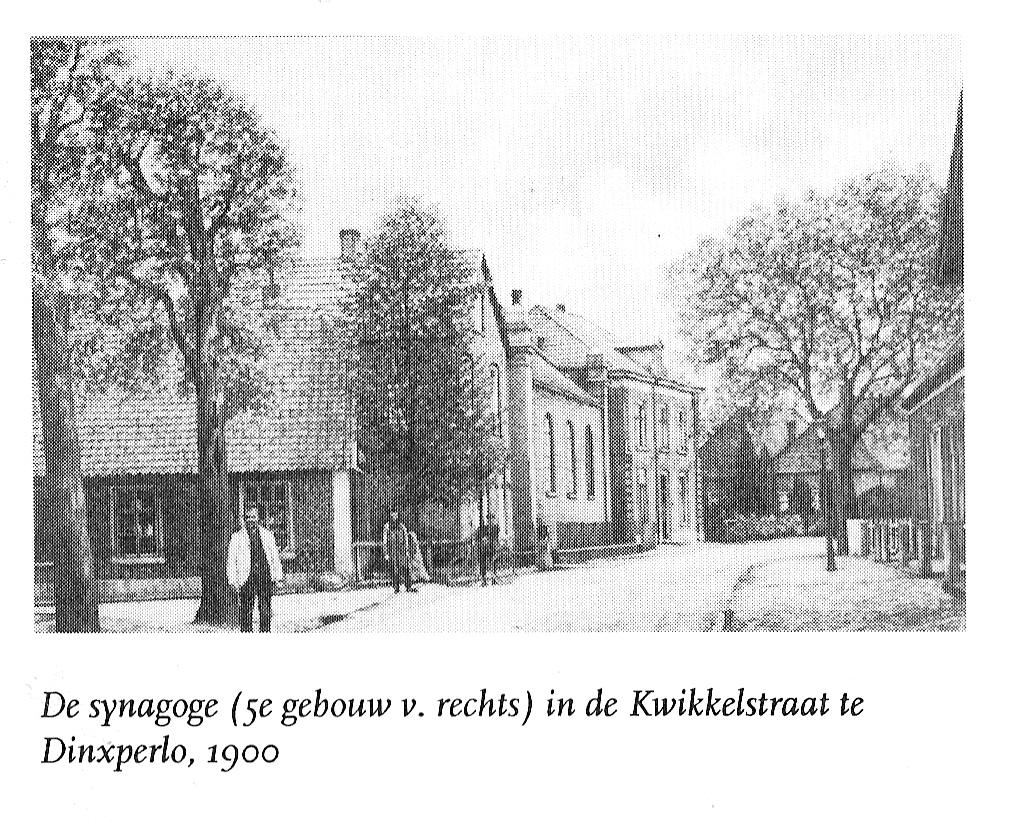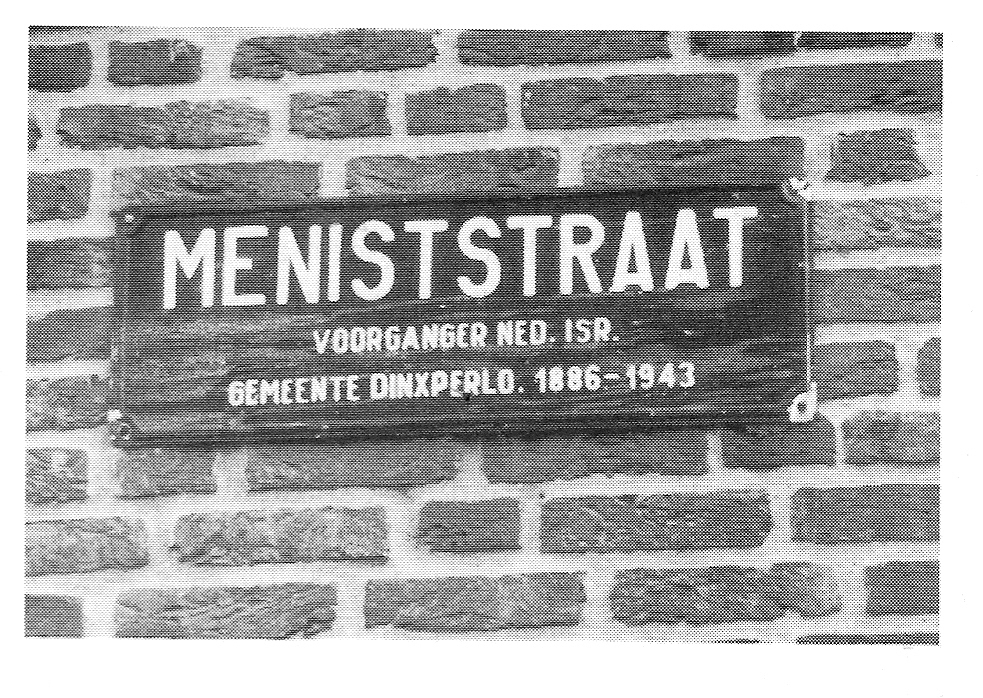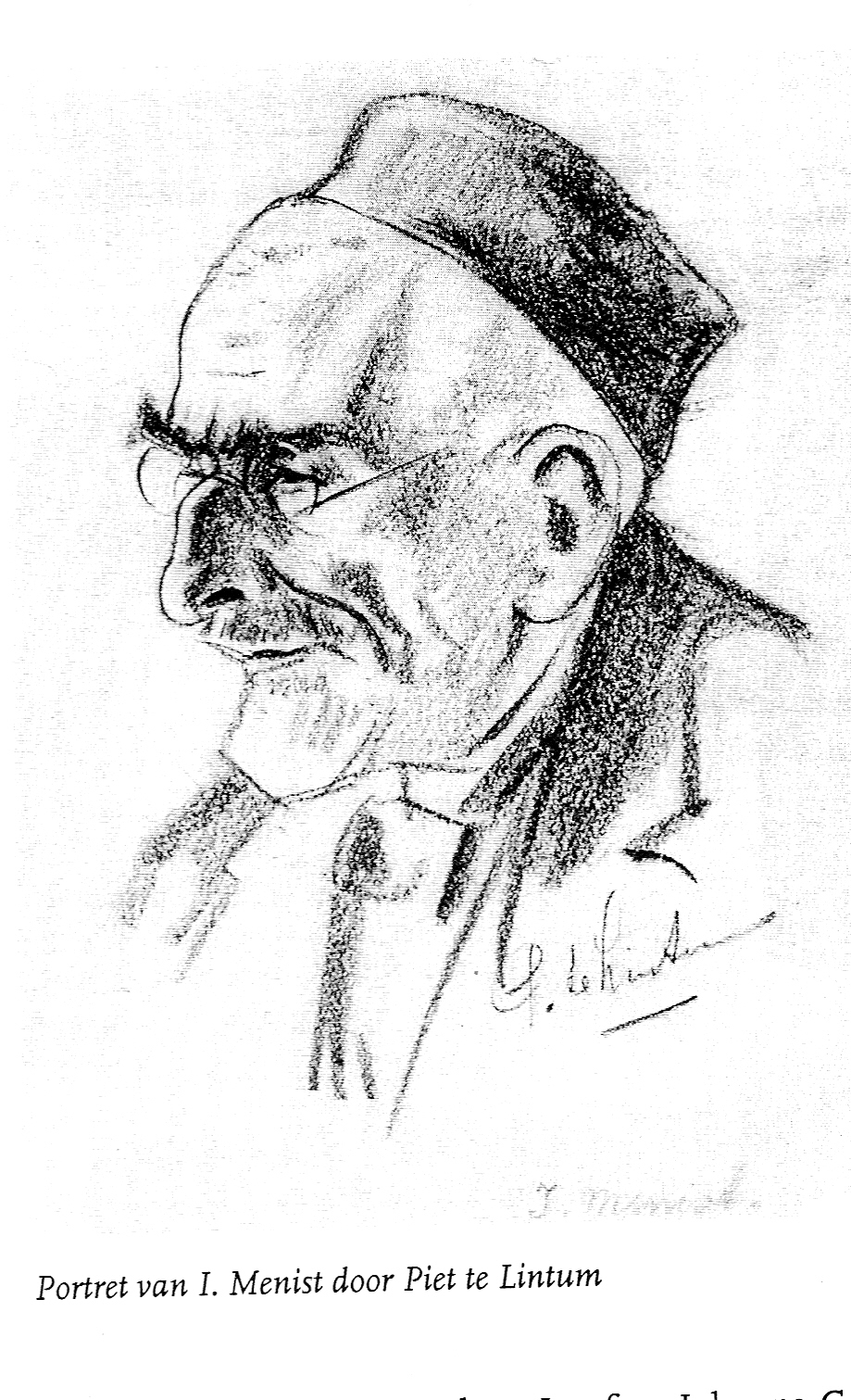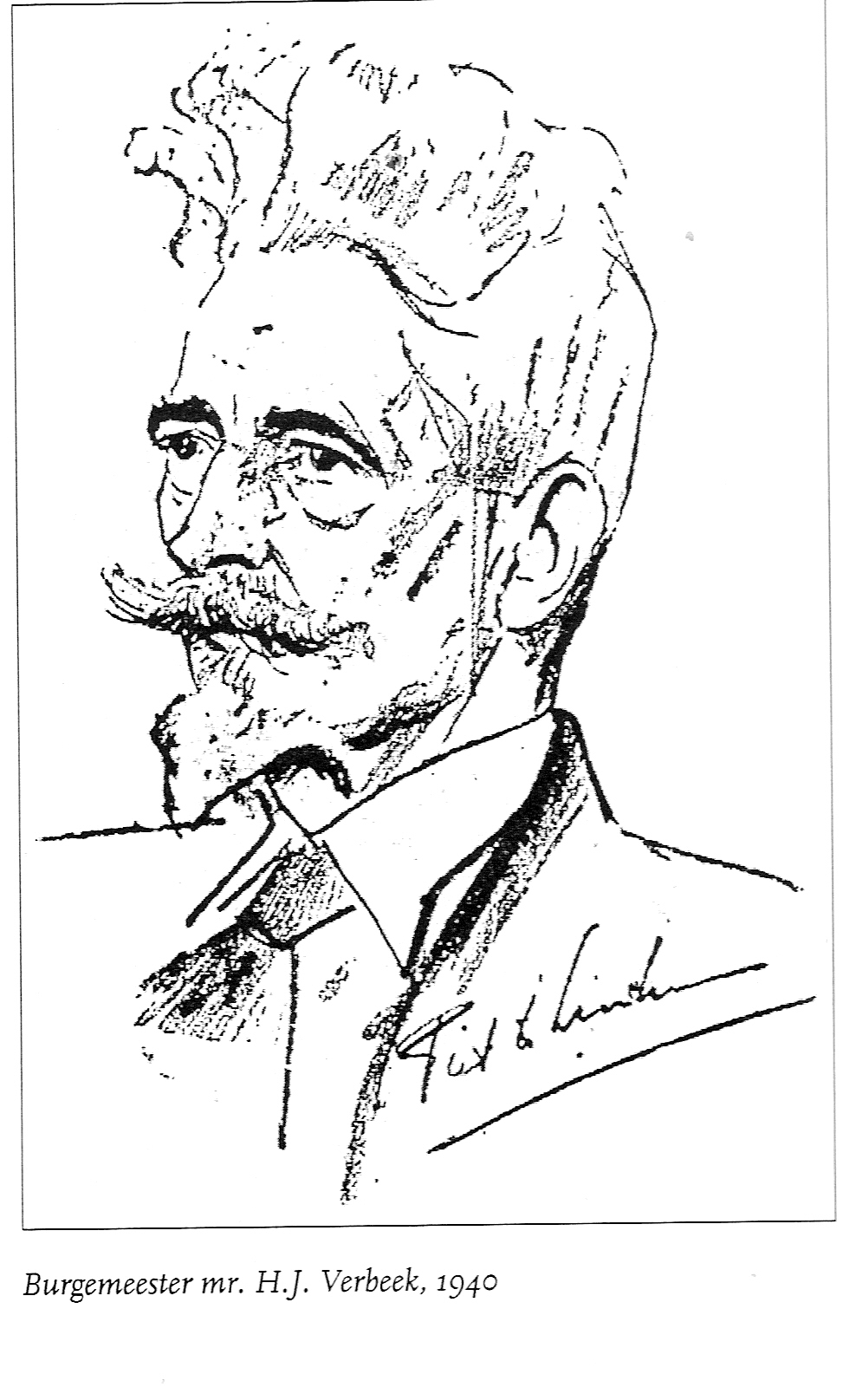The Jewish Community of Dinxperlo
Names mentioned in the article in order of appearance:
Till the names adoption (1811):
Jacobus Benjamin the Jew, Sibilla Levi, Abraham Cohen of Rees, Isaac Hartog Oppenheimer of Dinxperlo, Jacob Aron
After the names adoption:
Mozes Israel Fuldauer, Michael Gans, Meijer Mozes Fuldauer, Philip Mozes Fuldauer, Philip Schwarz, Eli Heijmans, Wolf Salomon, Mozes Pagrach, H. Pagrach, Abraham Heilbron, Leeman Heilbron, Philip Fuldauer, Jeanette Cohen, Salomon Levy de Jong, Isaac Mennist, Chief Rabbi Levisson, Chief Rabbi L. Wagenaar, Abraham Fuldauer, Leo Heilbron, Maurits and Frederika Prins, Benjamin Prins, Maurits Benjamin Prins, Maurits Philip Prins, Hendrik Verbeek(mayor of Dinxperlo).
In the 18th century only a few Jews lived in Dinxperlo. In December 1715 a plaintiff wanted to confiscate the goods of the Jew Benjamin because of a claim of 70 guilders in Dutch money that had been borrowed by Benjamin Jacobi in May 1711. In 1748 Jacobus Benjamin the Jew and his mother Sibilla Levi lived in a house near the border.
Jewish names appear again in 1800 in the protocols of Dinxperlo. In the spring of 1800 there was a lawsuit between Abraham Cohen of Rees and Isaac Hartog Oppenheimer of Dinxperlo.
In 1810 there lived 27 Jews in Dinxperlo and 15 in neighboring Werth. Jacob Aron served as gazan. Five family heads and two bachelors submitted their names and family names to the Municipality. In 1815 there were only four names left, mostly poor Jewish families and one bachelor. Mozes Israel Fuldauer was a licenced merchant and butcher who obviously was better off than the other families. On Shabbath the Jews of Dinxpelo and Werth came to his house to hold a service. Michael Gans who according to the list of adoption of family names lived in Kalkar in 1812, was exempted from military service.
Merchants and Butchers
A municipal report mentions the in 1815 ‘licensed’ merchant and butcher Mozes Israel Fuldauer as being "an industrious and well-behaved man who has obtained credit through his trade; he is thought to be rather well-to-do, although burdened with a household consisting of a wife and six children. His house also contained a room where the Jews practice their religion. The expenses and upkeep of all this, as well as of the Rabbi, who costs him every week 2 guilders and 10 pennies, are at his own expense. On Sabbath several Jews come to Dinxperlo from Werth in order to practice their religion, since locally there do not live enough members as is necessary to hold the services.
Meijer Mozes, son of Israel Fuldauer, was manufacturer by profession. He had stored rather big supplies of textiles in his house. During the night of January 2nd, 1837 his house was burgled and a lot of merchandize was taken. The burglars presumably escaped via the road to Terborg.
Philip Mozes Fuldauer, also a son of Mozes Israel, was the first person in Dinxperlo who started some industrial activities. In 1830 he started a house for dyeing in blue of textile materials in the town. Fuldauer had married three times and had 21 children. Apart from Dinxperlo, he also lived in Winterswijk, Gendringen, Aalten and Terborg.
About the families who lived there during the period of 1812 – 1890 only a few facts have been preserved.The family name of Schwarz appears around 1880 in legal documents. Thus, Philip Schwarz, tradesman in Dinxperlo, took a mortgage on his house , yard and a building plot from the Geldersche Credietvereniging in Arnhem . According to the custom in the Achterhoek, auctions of clothing, textile remnants, household goods and suchlike were held regularly. On December 22nd, 1887 notary's clerk Eli Heijmans arrived in Dinxperlo from Groenlo at the request of the Amsterdam merchant Wolf Salomon in order to auction off a party of drapery goods. Remnants of cotton cloth, horse-cloths and other textile goods went very well. In 1902 Mozes Pagrach received a permit to establish a beef and veal butchery and in 1906 H. Pagrach received a permit for the same purpose. Mozes kept his business until 1942, after which the German occupiers took over the business. In 1903 Abraham Heilbron received a permit to establish a tannery of cow- and calves hides. In that same year Leeman Heibron was allowed to run a calf- and beef butchery.
Philip Fuldauer, a 21-year-old greengrocer, got married in 1908 in the synagogue of Bocholt to 20-year-old Jeanette Cohen. Philip got tuberculosis and died on October 7th, 1909. Jeanette remarried and later became a well-known emancipated politician.
The Synagogue
As has been mentioned above, Mozes Fuldauer had a house synagogue around 1810 for about 20 persons, including Jews from Werth and as mentioned before, the expenses were on him as well. The house synagogue was not in the best condition. Not much is known about this small synagogue. During the period (of around 1810 to 1830) the Chazan was Salomon Levy de Jong.
(Some anecdotes on Salomon Levie (de Jong) and his descendants)
In 1850 the Jewish communities of Varsseveld and Dinxperlo belonged to the secondary synagogue of Aalten. In that same year these communities paid their contributions for the Chief Rabbi and the Rabbi of the Department of Nijmegen to the council of synagogues at Aalten. In the same year the High Commission in The Hague officially recognized the Jewish Community in Dinxperlo. In a committee report of the year 1851 the following is mentioned: "The Israelites have a tiny synagogue and a chazzan." In the reports about the condition of the community during the period 1856 – 1866 they mentioned among others: "The synagogue is in a state of disrepair" and "condition of that building, as well as that of the mikve and the staff was less than satisfactory".
The community report also mentioned that 57 Jews lived in Dinxperlo in 1860, in the "adjunct synod" of the Jewish Community". During the period of 1851 to until 1866 there was no officiating chazzan. According to the report of 1860 the synagogue was in such a state of disrepair that it was decided in 1865 to start using a rented hall. In 1886 the religion teacher/chazzan Isaac Mennist of "Mokum" (Amsterdam) was appointed in Dinxperlo. He would spend his whole life in the "Achterhoek", until the German occupiers deported him to a concentration camp in 1943. The job of rebbe, like in many small communities, did not pay enough to live on and was too much to die from. Mennist had therefore two secondary jobs: that of bookkeeper at the butter factory and he was also correspondent for several newspapers. On his 75th birthday Mennist was congratulated by Chief Rabbi Levisson, who pointed out that he had been active in the community for no less than 55 years!
On Sunday, February 17th, 1889 the solemn inauguration of the new synagogue took place. On this festive Sunday morning the torah scrolls of the old synagogue were brought to the new synagogue and the choir sang the song of welcome from Psalm 118. In the new synagogue services were held on Friday evenings, three times on Shabbath and during the Jewish Holidays. During one of these services Chief Rabbi L. Wagenaar held a ceremonial speech.
The celebration for the synagogue's 50 year existence on Tuesday, March 7th, 1939 was not a festive one because of the situation in the neighboring country. Abraham Fuldauer and Leo Heilbron, who had attended the inauguration in 1889, were guests of honour at this ceremony.
The cemetery
Very little can be told about the cemetery in Dinxperlo. Next to the synagogue that was built in 1889 was also an old Jewish cemetery. Around 1800 the Jewish families also kept a small Jewish cemetery next to the house synagogue of Mozes Israel Fuldauer. It seems that this small plot had also served around 1864 as "a market-place and fairground". A smith had asked to build a forge in 1864, but the municipality would not grant a permit.
Industry, mainly carpet factories
During the years 1840 – 1880 many inhabitants of Dinxperlo earned their living from cotton weaving and many of the 420 breadwinners subsisted as linen weavers. In 1882 the municipal administration gave a permit to the Deventer carpet manufacturer Prins to build a weaving mill and dye-house. He had a large carpet factory built in which many employees could earn their living. During this period there also existed two blue-weaving mills where many linen weavers earned a living. The Prins family, Maurits and Frederika and their four children had settled in Dinxperlo in mid-1882. They paid good wages and provided good social care, such as sick-funds and unemployment funds. They also saw to it that a district nurse would be employed. In 1889 the provisions of the sick-fund were put at the disposal of the factory.
Benjamin Prins was town councilor from 1920 to 1929, the last two years of which he was alderman. The son, Maurits Benjamin Prins was chairman and board member of several institutions in Dinxperlo. Nephew Maurits Philip Prins was also active in local politics and institutions. Thus in 1929 he became a member of the town council and in 1933 he was both alderman and deputy mayor – all this until April 1940. At the same time he was also among others member of the board of the civic guard. The Prins family also took the initiative to have Dinxperlo connected to the telephone and electricity nets. In 1904 the management of the carpet factory strongly promoted the connection of a telephone line from Dinxperlo to Terborg. In 1907 the employees of the factory have, as mentioned in the municipal report of that year: established a "new sick- and relief-fund, starting from the 1st of January, enabling free choice of doctors and members can be treated in the normal way when they are sick."
In 1916 70 adults worked at the carpet factory, 18 boys and 4 girls and 10 years later 120 adults worked in two carpet factories.
Border Perils and Refugees
After the nazi's had taken over power in 1933 and boycotted the Jews in April 1933, many Jews left the neighboring country. At the beginning of 1934 around 4200 refugees were registered and the number of non- registered persons was estimated at 800. In the Thirties a bishop from Germany came to visit Dinxperlo and the Jew Fuldauer hung a huge banner in front of his house with the text: "Although I am an Israelite, I celebrate together with the Bishop".
In May 1938 the Netherlands offered shelter to 25000 German refugees, about 75% of whom were Jews. In the synagogue of Dinxperlo the chazzan said a special prayer during services since November 1938 because of the emergency in Germany. The mayor of Dinxperlo, Verbeek, established a special committee with the request:" to offer help to persons persecuted because of race or religion". On December 3rd, 1938 a special collection was held for the persecuted persons. The above-mentioned Mayor Verbeek was of great help to the refugees. Through his mediation, among others, a Jewish family in Terborg took in a group of refugees. Mayor Verbeek led a large collection for the mainly Jewish refugees and he showed special sympathy with the fate of the Jews in the German speaking countries and those occupied by the nazi's. He did not hesitate to extend residence permits to refugees, which he did till end December 1938. Suddenly there appeared reports in newspapers that the popular Verbeek had been put on sick leave. This was a great shock to all inhabitants of Dinxperlo. It was held against Hendrik Verbeek that he applied with too great flexibility the stringent rule of the ministry of justice, namely that only if someone was threatened with "immediate danger of life" a residence permit should be given. Verbeek did everything possible to save people. He took into consideration that he infringed the rules. Nevertheless, he as well as his colleague in Gendringen, did everything possible in order to save people and they were the exceptions. In other municipalities in the neighborhood much less was done to keep the refugees from the claws of the nazi's. Verbeek was betrayed by "trustworthy persons" who complained about him to the police which led to court trials and in the end to dismissal. Mayor Verbeek’s achievements during his term of office were substantive: the improvement of roads and the building of a new municipal building are only two items among many others. He survived the war and died on January 22nd, 1946.
As far as the kehilla Dinxperlo concerns – in July 1947 it was officially abolished and annexed to Aalten.
Source:
Hans Kooger “Het Oude Volk”, pag.151-172.
With reference notes in the original on pag.172-175 (in Dutch)
Published by “Staring Instituut/Mr.H.J.Steenbergenstichting”, Doetinchem, 2001 (Slightly revised).
with permission of the author
Extracted and edited by:Trudi & Berrie Asscher
Translation into English:Nina Mayer
Final editing:Trudi Asscher, Ben Noach
The short chapter Some anecdotes on Salomon Levie (de Jong) and his descendants was contributed by Yael Ben Lev-de Jong from her family archives.
[an error occurred while processing this directive]
[an error occurred while processing this directive]

|
|
| De synagoge in de Kwikkelstraat Dinxperlo 1900 | |

Bordje Meniststraat |

Portret van Voorganger I. Menist |
 |
|